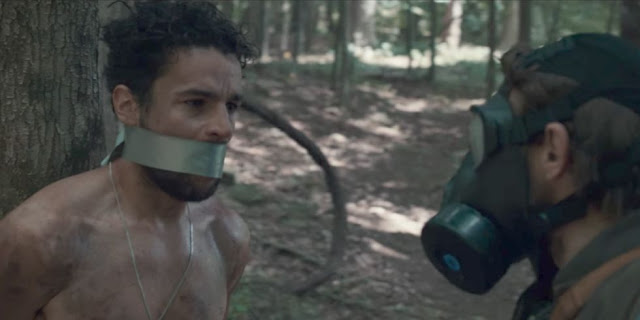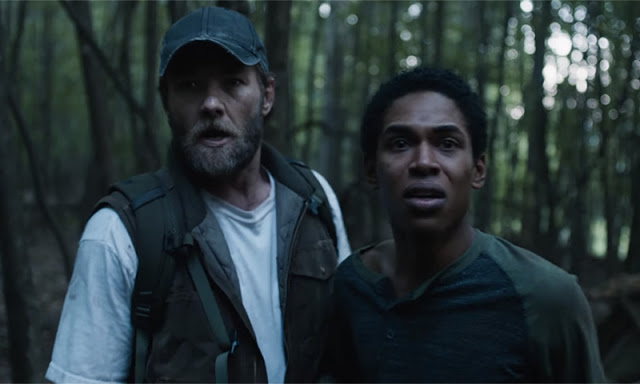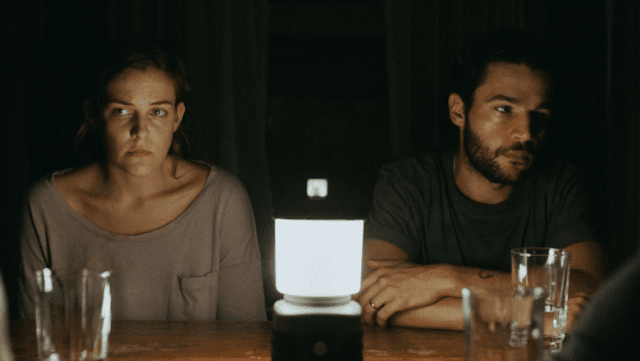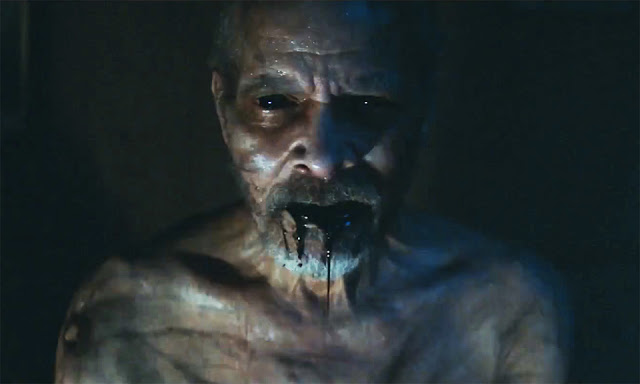There are no zombies in It Comes at Night, unless you count the vacant, dead-eyed stares that regularly materialize on each of its characters’ stricken faces. An eerie shiver of a horror-thriller, it’s scary less for its shocks than its sober observations on human nature. When a body is burned in the film’s harrowing opening sequence, the corpse never reanimates, though it does emerge in a spooky, silent nightmare, darkened eyes shooting daggers of ill will. In this movie, the dead stay dead. Maybe they’re the lucky ones.
The second feature from writer-director Trey Edward Shults, It Comes at Night takes for its premise that all-too-plausible scenario that has beckoned to many an aspiring artist: the apocalypse. Doomsday has long fascinated filmmakers, who relish the chance to turn a universal fear—it’s the end of the world!—into a personal vision; the last few years alone have given us works as varied as the demolition derby of Mad Max: Fury Road, the steampunk allegory of Snowpiercer, and the bro-sploitation comedy of This Is the End. It Comes at Night is quieter than those movies, but it is arguably more unsettling. For Shults, the collapse of civilization creates the opportunity to explore how people relate to and value one another, pitting civic values against Darwinian impulses. The picture he paints, much like the ghastly mural that adorns one of the walls of the house where the action occurs, is far from pretty.
That house is nestled deep in the woods, a pretty but blankly generic location which suggests that the horrifying events of this movie could take place pretty much anywhere. Shults is intentionally vague with details; there are whispers of devastation in the cites, but all we need to know is that people are dying of a mysterious sickness. Besides, he says far more with gestures and images than with cumbersome exposition. That aforementioned opening begins with a close-up of an old man, Bud (David Pendleton), wheezing heavily and pocked with boils. As an unseen female voice offers plaintive encouragement (“You can just let go”), the camera slowly circles around, revealing three watchful figures, all wearing gas masks. After a short stroll down a leafy hillside, a shallow grave is dug, and a mercy killing performed.
The executioner is Paul (Joel Edgerton, characteristically compelling), who lives in the house with his wife, Sarah (Carmen Ejogo, battling a far different menace here than she did last month in Alien: Covenant), and their teenage son, Travis (Kelvin Harrison Jr.). (There is also the family dog, the better to sense evil spirits with.) Their solitude, which consists mostly of silent dinners and tedious chores, is interrupted by the arrival of Will (James White’s Christopher Abbott), who unwisely breaks into the house in the dead of night and finds himself facing the business end of Paul’s rifle. Before Will knows it, he’s trussed up to a tree with a hood over his head, in danger of dying of thirst unless Paul takes pity on him, and Paul doesn’t scan as the pitying kind.
Will’s attempted burglary and Paul’s subsequent abduction of him help frame the central inquiry of It Comes at Night: How do you conduct yourself in a world with no rules of conduct? Stripping away the niceties of polite society, the film examines the inherent tension between our learned behavior and our survival instincts. “You can’t trust anyone but family,” Paul tells Travis, and maybe he’s right, but Shults blurs the line between valiant protectionism and willful fanaticism. There may not be any true villains in this movie, but there definitely aren’t any heroes.
Despite Paul’s misgivings, he and Sarah eventually do place some faith in Will, inviting him and his family—his wife, Kim (shooting star Riley Keough, of American Honey and The Girlfriend Experience), and young boy, Andrew—to share their home and their labors. But while It Comes at Night touches on the toils of self-sufficiency—there’s even a surprisingly pleasant wood-chopping lesson that recalls the sudden burst of contentment in Dawn of the Dead—Shults is not overly concerned with practical minutiae. He’s more interested in the tentative interpersonal dynamics that blossom and wilt between these two clans as they get to know one another, such as the awkward way Paul welcomes Will and Kim and simultaneously lays down the law (he’ll remain keeper of the keys), or the disconcerting habit Travis develops for clambering through the crawl space in the attic to surreptitiously observe his new houseguests.
The latter is decidedly icky, but don’t judge the kid too harshly. Of all the miserable predicaments that the characters face in It Comes at Night, perhaps none is more distressing than the agony of being a horny teenager when a married babe moves in across the hall. Travis’ burgeoning lust recalls It Follows, that revelatory picture that turned a hoary horror convention—directors punishing women for their sexual desire—into its very own supernatural monster. It Comes at Night isn’t as bold or explicit with its metaphor, instead presenting Travis’ psychosexual confusion as yet another layer of the underlying uncertainty that afflicts all of the characters as they try to play house. In the movie’s standout sequence, a dreaming Travis imagines Kim visiting his bedroom and straddling his supine body, a fantasy that morphs into a nightmare when she lowers her face next to his and vomits black blood into his mouth.
That scene is a knockout, but it also betrays Shults’ overreliance on dream sequences, a cheap way of injecting manufactured terror into a film that’s already throbbing with dread. Perhaps he felt obligated to prove his horror bona fides, though he largely (and gratifyingly) shuns the temptation of the jump-scare. Regardless, the bleak reality of It Comes at Night renders its creepy fantastical moments almost superfluous. Well-staged though it may be, there’s no real need for the scene where Travis hallucinates Bud’s return, his irises welling up into demonic pools of black liquid.
All the same, that unnecessary flourish confirms Shults’ impressive command of tone and composition. His first feature was Krisha, a deeply unpleasant domestic melodrama that bore the visual and aural marks of a horror movie, with the added kick that it starred his actual family. It was also astonishingly self-congratulatory—at one point, the title character reassures Shults (playing himself) that he’s a tremendously gifted filmmaker—but its boastfulness was not entirely unjustified. With It Comes at Night, Shults continues to hone his directorial talents but ditches the gimmickry; this is an honest-to-god movie, not a flashy formal experiment. He favors long, silky takes, his camera gliding ominously down narrow hallways or lingering uncomfortably over people’s faces. The portentous image he returns to again and again here is the house’s ruby-red front door, a simple gateway that eventually acquires a mystical significance, as though it’s a portal to another world, one rife with unknown threats and invisible pathogens.
That may be strictly accurate, but it also undersells Shults’ sly misdirection, the way he focuses your attention outdoors when the real danger is lurking inside. It Comes at Night can’t quite be called a classic contemporary horror movie—it lacks the electric verve of It Follows or the delectable period detail of The Witch—but it doesn’t necessarily want to be a horror movie. In fact, in its modest scale and dystopian premise, the recent film that It Comes at Night most closely resembles is Z for Zachariah, a pensive triangular romance that turned the problems of three little people into the entire crazy world. Where that movie was gentle and empathetic (if ultimately depressing), this one is cold and mean, but both use their apocalyptic scenario to probe our collective psyche and uncover basic human truths.
And that—even more so than for its burning bodies and bleeding animals—is where It Comes at Night is genuinely disturbing. It posits a future (or perhaps it’s the present) where communication breaks down, suspicion festers, and strong and weak die alike. It’s a world where every conversation is pregnant with sidelong glances and hidden agendas, where courteous inquiries (“Is everything OK?”) double as loaded accusations. Viewers will surely puzzle over just what “it” means, but the film’s title is actually deceptive on multiple levels. The real evil depicted in this movie—the abiding mistrust of man—isn’t exclusively a creature of darkness. It comes at daybreak, too.
Jeremy Beck is the editor-in-chief of MovieManifesto. He watches more movies and television than he probably should.




